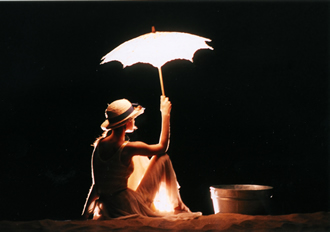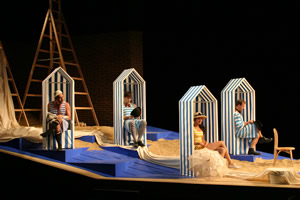
Theater Games
By Kathleen Dimmick
Lady with a Lapdog
Adapted from the Chekhov story
by Kama Ginkas
American Repertory Theatre
64 Brattle St.
Cambridge, MA
Box office: (617) 547-8300
What is the theatrical potential for nondramatic
narrative prose? Can it be made compelling in the theater? From
avant-garde experiments in the early 20th century through story
theater techniques in the sixties to recent, popular adaptations
of novels by Dickens and Twain (and Ovid) in regional theaters
and on Broadway, the adaptation of nondramatic texts for the theater
continues to tempt theater artists. Kama Ginkas, a Russian director
who has adapted other prose works for the stage, notably Chekhov's
The Black Monk and Dostoevsky's Crime and Punishment,
is clearly engaged by the process of theatricalizing prose narrative,
and his latest adaptation of a Chekhov short story plays on the
distinction between theater and drama.
Arguably Chekhov's best known story, Lady
with a Lapdog (1899) tells the deceptively simple tale of
Gurov, a forty-year-old Moscow businessman, who begins an affair
with Anna Sergeyevena, an unhappy young wife he meets while both
are vacationing at the Crimean seaside resort of Yalta. When Gurov
returns to Moscow, he discovers, to his surprise, that he cannot
forget Anna Sergeyevna as he has forgotten so many previous liaisons.
He makes a secret trip to her provincial town, and encounters
her in a theater. She begins to visit him secretly in Moscow,
and the story ends with a typical, and beautiful, Chekhovian non-resolution:
Gurov and Anna recognize that their love for one another will
force them to create a second, secret life full of struggle, one
in constant tension with their ostensibly "real" lives of business,
marriage, and family. Written in four parts like his plays, the
story moves in nearly imperceptible jumps and starts, creating
a reality that breaks many rules of traditional narrative realism.
Gorky wrote to Chekhov after reading the story: "You are killing
realism...That form is finished, that's a fact! Nobody can go
further down that road than you have done. Nobody can write so
simply about ordinary things as you can."
Ginkas is working with his long-time collaborator,
set and costume designer Sergey Barkhin, and with lighting designer
by Michael Chybowski, and his production is often literally brilliant,
the lighting and stage design contributing in large measure to
the theatrical experience of the piece. The ART stage has been
re-configured as a narrow platform of blond wood, stretching from
wall to wall with no wing or back stage space; an upstage pit
allows actors to appear and disappear in one of the many physical
motifs of the staging. (Actors also enter and exit through the
house.) Two very tall ladders (resembling tech ladders) dominate
stage right. A blue box with a blue boat suspended inside hangs
up center, forming a kind of floating, three-dimensional backdrop.
As the location for the first half is the seaside resort, the
set consists mostly of blue and white striped bathing huts, resembling
little comical gendarme kiosks, which the actors manipulate as
large movable props. The stage is partly covered with sand, and
Chybowski's lighting creates the heat and glare of a summer beach
resort. The initial costumes replicate the look of the bathing
huts: one-piece striped bathing costumes, somewhat absurd on the
men, fetching on the Lady. A sophisticated sound design (by David
Remedios) combines original music (by Leonid Desyatnikov) with
realistic and nonrealistic sound effects. Its presence is strong:
loud interruptions alternate with quick fades, underscoring, punctuating,
and literally illustrating theatrical moments.
Ginkas employs several theatrical strategies
to make a theater piece out of Chekhov's quintessential prose
description of human struggle and unhappiness. The first and perhaps
clearest signal that this is not going to be a "realistic" adaptation
is the addition of the two Gentlemen Sunbathers, who are nothing
more or less than clowns, each with a virtual bag of theatrical
tricks: red noses, commedia dell'arte lazzi, and assorted physical
hi-jinks. They serve to interrupt and disrupt, both the performance
itself and Gurov, plaguing him with distractions in his pursuit
of Anna. They torment him (and often delight us) with their interruptions
(they function like the score, in that sense) -- throwing sand,
spitting water, blocking Gurov's movements. In one particularly
hilarious gesture, all three march forward, holding their blue-striped
bathhouses horizontally, like cartoon phalluses, as they compete
to be the first to reach Anna.
Another strategy is Ginkas's manipulation
of the text. (Chekhov's story was newly translated for this production
by Ryan McKittrick and Julia Smeliansky.) There is much verbal
overlapping, and in the initial erotic energy of their attraction,
Anna and Gurov compete to speak the narration, with Anna trying
to get equal time in recounting their respective back stories.
This competition to tell the story calls attention, in a playful
way, to the fact that the original story is definitely from Gurov's
point of view; it's his story, and Anna must fight to
remain a player. The narrative competitiveness soon drops off,
and in the second half we lose Anna almost entirely; she no longer
competes for a narrative voice.
The staging also parallels the growing
intimacy of the couple. At first the affair is all playful chases
and sand fights in bathing costumes, but as it proceeds to mature,
sexual love, Anna and Gurov begin to cover themselves in proper
costumes of the period. A beautiful coup de theatre depicts
their sexual union: Gurov climbs one of the ladders, carrying
a long strip of fabric which Anna, lying stage center, holds between
her legs. It's a stunning visualization of sexual passion, which
modulates into a haunting post-coital tableau, as the pair sit
high up on the ladders (now a park bench) and the dim, dawn lighting
transforms the comical bathing houses into eerie, haphazard coffins.
At the end of Part Two, as Gurov leaves the resort, a larger piece
of fabric, much like a stage drop-cloth, recalls the previous,
erotic prop as it covers the bathhouses to represent the grey
winter of Moscow.
Part Three traces Gurov's growing obsession
with Anna following his return to Moscow, and his subsequent journey
to her provincial town. A wooden fence rises up from the pit,
representing Anna's forbidding house. This section is narrated
solely by Gurov, and the time and attention devoted to his internal
questioning, his psychological ambivalence, and the increasingly
labored attempt to find gestural equivalents for this ambivalence,
slow the piece down considerably. This is no doubt intentional,
as the short fourth part moves quite quickly. Nonetheless it allows
us too much time to wonder and worry about the crux of Ginkas's
experiment: how resonant, how interesting, can a consistently
self-referential narrative voice be in the theater? A sort of
narrative fatigue sets in, as if Ginkas had also found himself
at a loss as to how to theatricalize this stretch of inner consciousness.
Then the fatigue is wiped out, however, by Ginkas's second coup
of the piece. Gurov, who is attending a performance of The
Geisha Girl at the local theater in the hope of seeing Anna,
sits center stage and addresses the ART audience, speaking the
narration. The story reads (translation by David Magarshack–I
could not obtain a copy of the ART translation): "As in all provincial
theaters, there was a mist over the chandeliers and the people
in the gallery kept up a noisy and excited conversation ... Gurov
scanned the audience eagerly as they filed in and occupied their
seats." At ART, there is a misty chandelier suspended over the
audience, which we notice as the house lights come up and Gurov
speaks directly to the audience. He notices who is coughing, who
drops a program, who looks bored, who might be about to talk back.
Who just walked out?! The sequence offers an extended opportunity
for a kind of phenomenological frisson, a time for the audience
to think and wonder about fictive time versus performance time,
story time in real time. 
The role of Gurov is wonderfully challenging,
as the actor must be in the role and outside simultaneously. Stephen
Pelinsky does well, communicating a strong physical and vocal
presence, but ultimately the production leaves one wanting something
more from him, perhaps unfairly. Some larger recognition of the
very complex line between narrative and drama that he's been treading,
or something on the order of what Brecht's great leading actors
achieved as they negotiated this fascinating ontological divide.
And while physically engaging, Elisabeth Waterston as Anna lacks
the vocal richness necessary to communicate the weight of her
story. Her lack of vocal color renders her somewhat insubstantial,
a disappointment since the story itself, as well as the staging,
tend to marginalize her.
In Part Four, Gurov visits Anna in a Moscow
hotel, where they're narratively and spatially trapped. Situated
against the brick wall of the theater, at the opposite end of
the platform from the sunny ladders of Yalta, the actors are confined
to a tight playing area that reflects their fate: a recognition
and acceptance of the reality of their love and the demands this
love will exact upon them. Gurov has aged suddenly, in both narrative
and theatrical time (glasses, stooped posture). Anna remains anxious
and weeping, a black-clad figure of unhappiness, as they try to
sort out how to continue to live this, their real life, in the
midst of their other, less genuine, failed lives.
There is much to admire in this two-hour,
intermission-less production. The design stimulates the visual
imagination and gives the story a rich three-dimensional life.
The metatheatrical devices create a sense of community in the
audience, at least fleetingly -- no small achievement. At the
same time, however, tedium sets in twice too often. The Gentlemen
Bathers and their antics grow tiresome, as does Gurov's self-referencing.
These gestures become too detached from Chekhov's story so that
one wonders what story is being told. Is it that of us sitting
in the theater watching this performance, or that of Gurov and
Anna? For all the wonderful inventiveness of his production, Ginkas
seems unwilling in the end to grant Chekhov's prose sufficient
power to truly blend with his own theatrical narrative into a
third, hybrid story. At issue, ultimately, is not just a debate
about the dramatic versus the theatrical, but about how to tell
a story in the theater.
